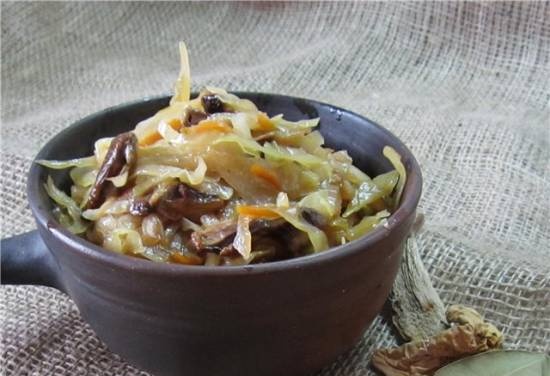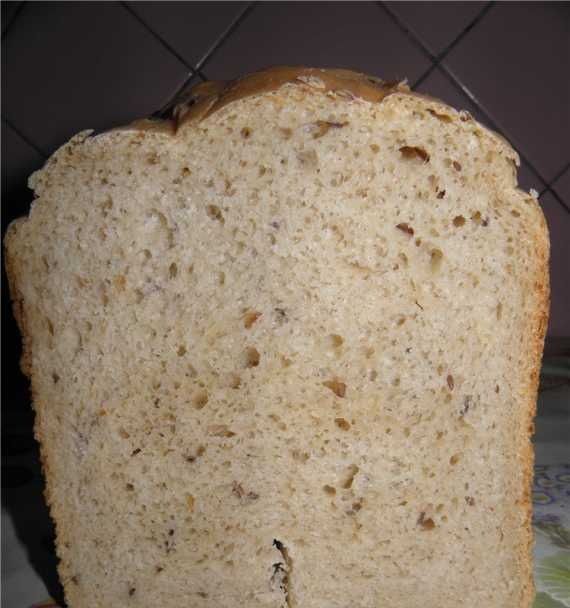|
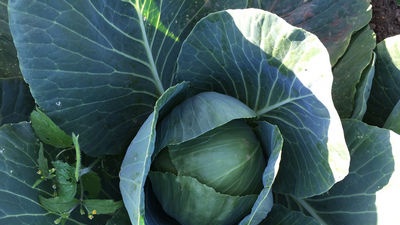 a) In cases where cabbage does not occupy the whole field of crop rotation, it should be placed in low, well-heated and moist areas. Cauliflower is especially demanding on soil moisture, which on dry or slightly moistened soils gives low yields of small loose heads. a) In cases where cabbage does not occupy the whole field of crop rotation, it should be placed in low, well-heated and moist areas. Cauliflower is especially demanding on soil moisture, which on dry or slightly moistened soils gives low yields of small loose heads.
b) Cabbage requires a good filling of the soil with organic fertilizers, but it gives the highest yields with the simultaneous introduction of organic fertilizers with mineral fertilizers. Manure, peat and municipal waste can be used as organic fertilizers. The rate of application of manure is not less than 40-60 tons per hectare.
With regard to manure fertilization, cabbage and cauliflower have their own characteristics. The first one gives good yields even with fresh manure, the second, in this case, develops a large number of leaves and small heads, therefore cauliflower should be planted with a second crop on manure or well-rotted manure should be applied under it. Urban rotted and cleaned waste is brought in in the amount of 80-100 tons per hectare.
It is better to put peat in the form of compost with feces in the amount of 30-40 tons. Compost from peat faeces is prepared in the following way: compost heaps are made 2 m wide and 2 m long, 1-4.5 m high. The heap is applied in layers: a layer of peat, a layer of faeces; 8-10 carts of peat are mixed with a 40-bucket barrel of feces.
After layering, the compost heap is well mixed, watered with slurry and left to decompose completely. Compost is considered ready when it has turned into a homogeneous crumbly mass - after about 5-8 months.
Cabbage succeeds very well in urban landfills, where, with appropriate processing, it gives excellent yields and an earlier yield than on ordinary soils.
In addition to these organic fertilizers, 2.5 centners of ammonium sulfate, 2.5 centners of superphosphate and 1.5-2.0 centners of 40% potassium salt, or 5-6 centners of wood ash should be added.
If organic fertilizer is applied in a reduced amount, then the rate of application of mineral fertilizers should be increased. Dung fertilizer is applied in the fall for the main plowing, and mineral fertilizer - in the spring for the first plowing or deep cultivation.
On light sandy loam soils for a medium variety of cabbage, manure can be applied in the spring for plowing.
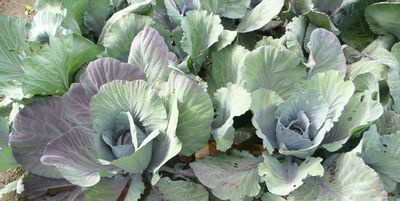 With a late variety of cabbage, manure is applied for the main plowing, and mineral manure for cultivation, in the spring. With a late variety of cabbage, manure is applied for the main plowing, and mineral manure for cultivation, in the spring.
c) Due to the special responsiveness of cabbage to organic fertilizers, it should be placed in the first and second fields of vegetable crop rotation, and in grass crop rotations - the first or second plant after perennial grasses.
d) In order to prevent the spread of diseases, it is necessary to return the cabbage to the same place of crop rotation no earlier than in 3-4 years.
Growing seedlings. The quality of the seedlings has an exceptional impact on the further development and yield of cabbage.
The stronger the seedlings, the sooner they ripen, the higher the yield. It takes 30-35 days to grow good seedlings.
Seedlings of cauliflower, require careful ventilation, are usually grown in greenhouses at a temperature of 10-12 ° C, while cabbage is grown at a temperature of 12-14 ° C (the temperature is given everywhere in Celsius).
To obtain good and strong seedlings, no more than 400 plants are grown under one frame in greenhouses, and plants per 1 square meter are grown in nurseries. If the seedlings in greenhouses or nurseries do not develop well enough, it is necessary to make fertilizing watering with mineral fertilizers, a solution of bird droppings or slurry.
Mineral fertilizers are applied per 1 frame, one bucket of water, in which 35 g of ammonium sulfate, 21 g of superphosphate and 12 g of potassium salt are dissolved. Watering with fertilizer can be started from the 15-day-old seedling age, when the plants will have 2 developed leaves. Before fertilizing, water the seedlings with water to keep the soil moist. After fertilizing watering, the seedlings must also be watered with clean water to wash off the fertilizers that have fallen on the leaves.
During the development of seedlings, it is necessary to make 2-3 fertilizing waterings. With the approach of the moment of planting seedlings in open ground, ventilation in the greenhouses increases, and watering decreases. In the last 8-10 days, greenhouse seedlings are accustomed to fresh air, leaving the greenhouses open not only during the day, but also at night, if frost is not expected. Seedlings of early cabbage should undergo especially severe hardening. By the time the seedlings are planted in open ground, it should have 4-b leaves. Only healthy seedlings are selected for planting, and those affected by a keel, black leg, other diseases and underdeveloped are culled.
Early cabbage is planted as early as possible, from about 10-20 May. But it is necessary to provide that there are no frosts for 3-4 days after planting the seedlings in the ground, then the seedlings will have time to take root well (take root) and can tolerate slight frosts.
Cabbage is protected from frost by means of smoke screens. Cauliflower should be planted multiple times to lengthen the period of use. For early plantings, seedlings are grown in greenhouses, and for later plantings, in nurseries.
The cabbage should be planted on a flat surface. Planting cabbage on the ridges is possible only in the northern regions on heavy soils, with a close occurrence of groundwater.
Cabbage is planted by planting machines, which, simultaneously with planting, irrigate, which increases labor productivity and facilitates the work of the worker.
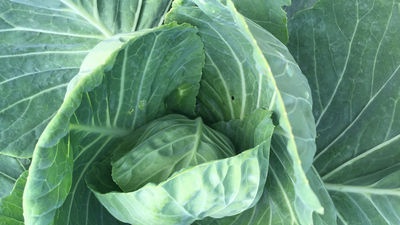 In the absence of planting machines, cabbage is planted manually, while the site is pre-marked. In the absence of planting machines, cabbage is planted manually, while the site is pre-marked.
Early cabbage and cauliflower are planted at a distance: in row spacing 50-60 cm, and in rows for cabbage 45-50 cm and cauliflower 35-40 cm, which is 18-24 thousand plants per 1 ha.
Medium varieties are planted at a distance: in rows of 70 cm and between rows of 60 cm or 70 cm in rows and between rows and late varieties - in rows and between rows of 70 cm.
Since cabbage slowly takes root, and during dry and hot weather it strongly sticks, planting should be done in cloudy weather or in the evening. To make the seedlings less affected, they must be planted with a clod of earth, immediately after planting, water at the rate of one 10-liter watering can for 10-12 plants.
If after planting there is dry and hot weather, then after 1-2 days watering is repeated. As soon as the water is absorbed into the soil, the holes are sprinkled with dry earth. In 5-7 days after planting, it is checked how the seedlings have taken root and, in case of a fallout, replanting is carried out.
Excellent results in increasing yields are obtained by mulching the soil in rows to warm it up more. Before planting seedlings, apply paper mulch. Mulching dramatically increases yields and speeds up yield.
In order to control weeds and keep the soil in a loose state during the summer, it is necessary to carry out at least three cultivations and shelves in the cabbage fields of early planting, and at least four in the middle and late ones. One decade after the first loosening, the plants are hilled. If there is insufficient precipitation, cabbage must be watered, and cauliflower is watered more often than cabbage. After each watering, the holes are covered with earth to reduce moisture evaporation and to avoid crust formation.
For better development of cabbage, during the growth period, feeding with organic or mineral fertilizers is carried out: from organic fertilizers, slurry, feces, bird droppings and mullein are used. From mineral - nitrogen, phosphorus and potash fertilizers.
Before watering, the slurry should be diluted 3-4 times with water. Prepared and fermented bird droppings are diluted with water 10 times and mullein 3-4 times. Watering rate: one 10-liter watering can of the prepared solution is consumed for 10-12 plants.
The solution of mineral fertilizers is composed as follows: for the first watering, 65 g of ammonium sulfate or 40 g of ammonium nitrate and 30 g of potassium salt are taken per bucket of water. Nitrogen and potassium fertilizers dissolve in water, while superphosphate and other phosphoric acid fertilizers are insoluble and for uniform distribution over the sowing they are applied dry under the plants in rows, before watering them with a solution of other fertilizers.
For the second and next watering, one bucket is taken: 90 g of ammonium sulfate or 60 g of ammonium nitrate, 50 g of potassium salt and 75 g of superphosphate.
The first top dressing is made in holes or grooves, which are made at a distance of 8-10 cm from the plants. With the second feeding, the holes are made at a distance of 12-15 cm from the plants, and the grooves are made in the middle of the row spacings. After each top dressing, the site is subjected to hoeing or cultivation for better incorporation of the applied top dressing.
Fertilizing cabbage is best done in wet weather. The first feeding should be done 10-15 days after planting, the second 15-20 days after the first and the third while curling the heads.
During the growth of cabbage, it is necessary to ensure that the areas are clean of agricultural pests and diseases and, if any, are found, immediately take measures to destroy them.
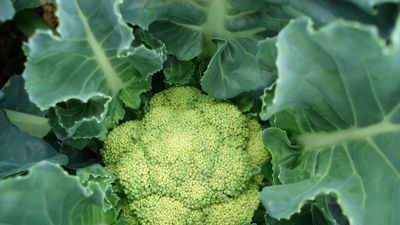 To get a good marketable production of cauliflower, the head of the cabbage is covered from the sun by breaking or tying the leaves. This is done when the head reaches 20-25 cm. To get a good marketable production of cauliflower, the head of the cabbage is covered from the sun by breaking or tying the leaves. This is done when the head reaches 20-25 cm.
Harvesting cauliflower should be done as the heads ripen, not allowing them to scatter.
Head cabbage in early and middle varieties is harvested in several steps, and in later varieties, usually in one step.
Vernalization of cabbage seeds. Vernalization of cabbage seeds is carried out to accelerate the ripening of the heads of cabbage and to reduce the time for growing seedlings.
Seeds begin to vernalize 17-22 days before the usual time for sowing in greenhouses or nurseries.
Seeds for vernalization are thoroughly cleaned of litter, broken and unripe grains, as they quickly rot. The cleaned seeds are weighed and poured into an earthen vessel with a layer of 3-5 cm. Then they are moistened with clean, but not boiled water in two steps. In the first and second steps, every 400 g of seeds are moistened with 200 g of water. The second wetting is done 3 hours after the first. Cover the moistened seeds with a wet rag so that it does not come into close contact with the seeds. An ordinary wall thermometer is placed next to the vessel where the seeds are germinated, which should show a temperature of 15-20 ° during the entire germination period. At first, every 3-5 hours, the seeds are gently but thoroughly mixed. When the peel of 5% of the seeds bursts, they are transferred to another vessel, with a wider bottom, and scattered in a layer of 1-2 cm. A dry, clean cloth or gauze is spread at the bottom of the vessel in one layer and the seeds are scattered, covering the top with a damp cloth , on top of which a thermometer is placed. The container with seeds is transferred to a vegetable store and kept at a temperature of 1-5 °. If after 1-2 days further seed germination is observed, then the vessel is transferred to a place of storage where it is driest and the temperature is no more than 1-3 °. You cannot overdry the seeds. To do this, the cloth at the bottom of the vessel must be moistened so that, under the strongest compression, water does not ooze out of it, while the upper covering cloth must be moistened strongly.Inspection of seeds must be carried out every day and, if rotten is found, remove them from the vessel. Sowing vernalized seeds should be done in exactly the same way as dry seeds.
I. Osipov - Agroindication
|
 a) In cases where cabbage does not occupy the whole field of crop rotation, it should be placed in low, well-heated and moist areas. Cauliflower is especially demanding on soil moisture, which on dry or slightly moistened soils gives low yields of small loose heads.
a) In cases where cabbage does not occupy the whole field of crop rotation, it should be placed in low, well-heated and moist areas. Cauliflower is especially demanding on soil moisture, which on dry or slightly moistened soils gives low yields of small loose heads. With a late variety of cabbage, manure is applied for the main plowing, and mineral manure for cultivation, in the spring.
With a late variety of cabbage, manure is applied for the main plowing, and mineral manure for cultivation, in the spring. In the absence of planting machines, cabbage is planted manually, while the site is pre-marked.
In the absence of planting machines, cabbage is planted manually, while the site is pre-marked. To get a good marketable production of cauliflower, the head of the cabbage is covered from the sun by breaking or tying the leaves. This is done when the head reaches 20-25 cm.
To get a good marketable production of cauliflower, the head of the cabbage is covered from the sun by breaking or tying the leaves. This is done when the head reaches 20-25 cm.

